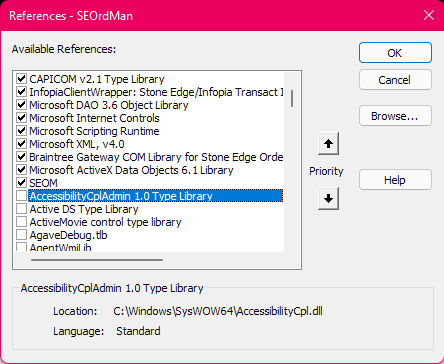Overview
As the Microsoft Access program file of Stone Edge Order Manager (SEOM) is used, it may become necessary to re-compile the program file to avoid problems running the application. This process can be accomplished manually through the MS Access database utilities, or Stone Edge Technologies Inc. has provided a standalone utility, called the OM Compiler, which allows the user to easily recompile the application’s program file.
If you’re experiencing frequent MS Access crashes while running SEOM or getting error messages such as ”Runtime Error: 3265 Item not found in this collection” or ”Runtime Error= 13 Type Mismatch”, try running the OM Compiler, which may resolve the situation. If not, contact SEOM Tech Support for further assistance.
About the OM Compiler
The OM Compiler is a utility that re-compiles, compacts, and repairs the SEOM program file, SEOrdManxxxyyyy.mdb (where xxx reflects the edition of SEOM, e.g. Enterprise, or POS; and yyyy is the version of Microsoft Access). This utility is located in your SEOM program installation folder and is run automatically during the installation of the program. This process does not affect, nor it is appropriate for, the store data file.
Running the OM Compiler
- Close SEOM on the computer that is experiencing the problems.
- The OM Compiler can be executed by one of the following methods, depending on the version of the program and operating system:
- Start > All Programs > Stone Edge Technologies > OM Compiler
- Double-click the file, c:\StoneEdge\OM Compiler.mdb (the default installation location is c:\SEOM, but select Info on the Main Menu or press CTRL+Shift+C to verify the path to the location of the program file).
- When the screen opens, click Compile. The file name at the bottom of the screen is the file that will be re-compiled.
- The message ”Compacting data file, please wait” will eventually appear in the lower left-hand section of the screen. This message is referring to the SEOM program file, not the store data file.
Note1: If you receive a message saying that “SEOM appears to be running” and it is not, close OM Compiler, go to the folder where the program file resides and look for a lock file with the same name as the program file (SEORDManxxxyyyy.ldb; this is not a typographical error, it is the extension that denotes that it is a lock file, and it is 1KB in size). Lock files are often left behind when an Access program ends abnormally. Delete this file and then re-open the OM compiler utility and repeat steps 2-6.
Note2: If the program file noted at the bottom of the window is not the correct program file, click Exit and follow the directions in the next section for manually re-compiling the program file and the directions in the article Compact and Repair Database to manually compact the program file. This situation can occur when multiple versions of SEOM are installed in the same folder (if the program is not uninstalled before upgrading).
- When the process is complete, Done! a message box pops up. Click OK and Exit to close the utility.
- Launch SEOM normally.
Manually Re-Compile the Program
- Close the SEOM program.
- Press and hold down the Shift key while double-clicking the SEOM shortcut on the desktop to open the database window.
- Press Ctrl+G to open a Visual Basic window.
- From the MS Visual Basic menu, select Debug > Compile Stone Edge.
- If Compile Stone Edge is grayed out, then take the following actions to force a re-compile of the program. Otherwise, skip to Step 6:
- Go to Tools > References.
- Click in the first unchecked check box (make a note of the label of the box that you check).
- Click OK.
- Go to Debug and click Compile Stone Edge from the drop-down list.
- Go to Tools > References.
See Figure 1 Below - Clear the check box you selected previously.
- Select OK.
- Go to Debug and click Compile Stone Edge from the drop-down list.
- When the program file has been re-compiled successfully, close the Visual Basic window, close the Microsoft Access window and re-start SEOM normally.

